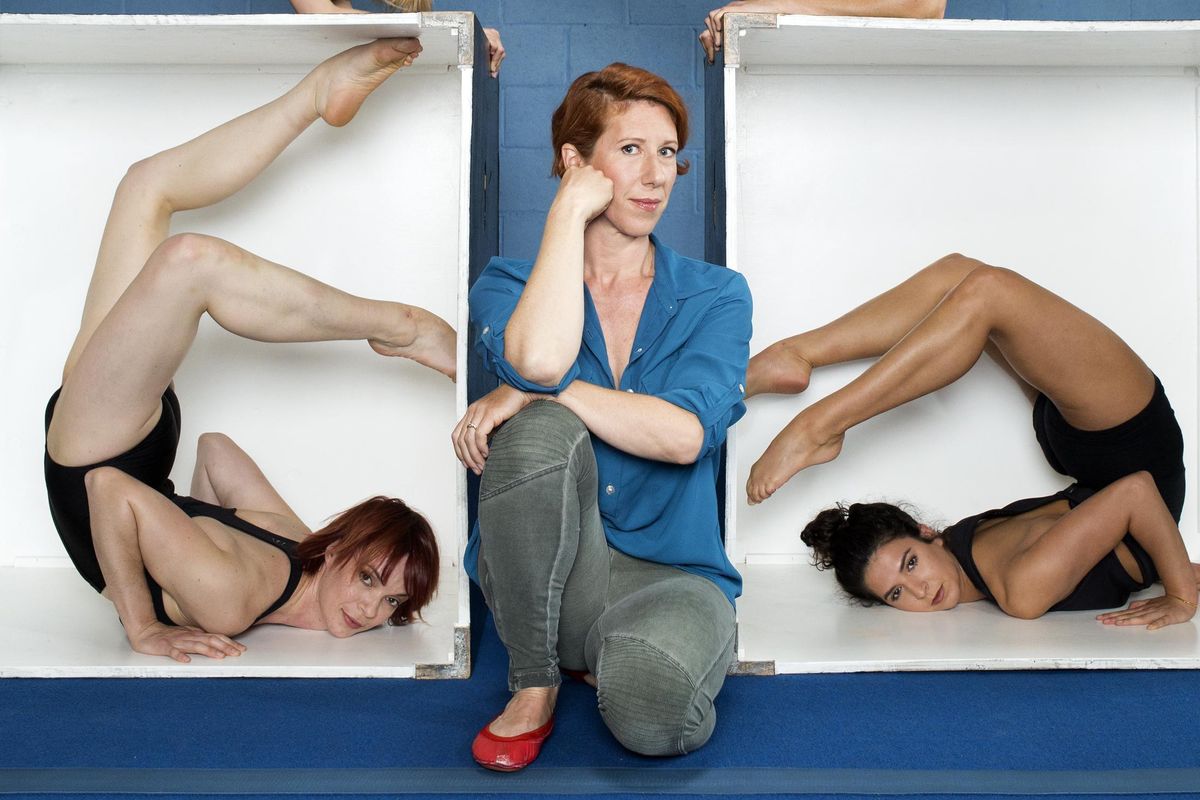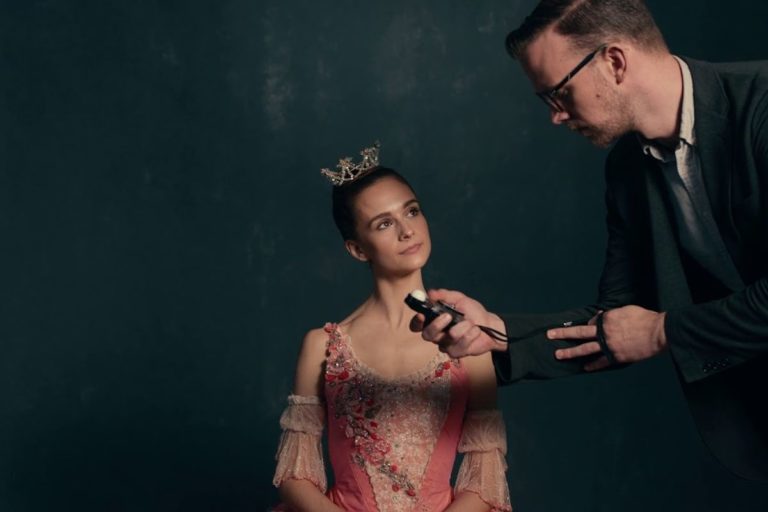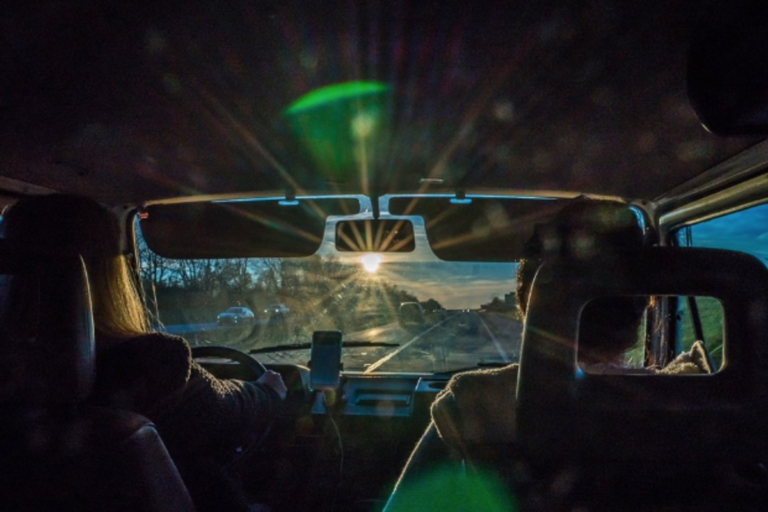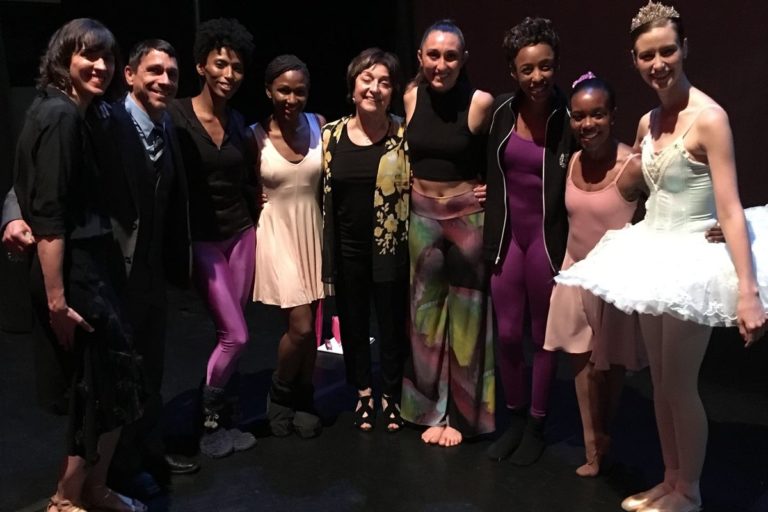
Funky jazz music fills the space as a trio of advanced contortionists twist in unison. Across the room, burgeoning trapeze artists are building core strength atop Pilates balls. And in another corner, a group of beginners attempts to master the proper foothold for shimmying up the smooth aerial silks.
It’s a typical lively night at Cirque School, a circus-arts training studio set in an open warehouse-style space in Hollywood. The school attracts all types of enthusiasts—from amateurs looking for a unique fitness challenge to pre-professional Cirque du Soleil hopefuls. Celebrities like Reese Witherspoon and Christoph Waltz have trained at Cirque School, as well as cast members of productions like NBC’s “The Cape” and CBS’ “The Defenders.”
And at the heart of it all is proverbial ringmaster Aloysia Gavre, who founded the school in 2009 on the heels of an illustrious career with Cirque du Soleil. Though she specializes in aerial hoop, Gavre is well-versed in all circus disciplines. Now she’s spreading the love, one student at a time.
“Circus led me to feel empowered and part of something bigger than myself. It allowed me to push my body to an absolute extreme, while not losing sight of beauty, grace and presence,” she says. “After years touring and performing with Cirque du Soleil, I found the need to share that empowerment with the general public.”
At Cirque School, everyone is welcome—in fact, the school’s motto is “For Anybody with Any Body.” About 80 percent of the 400 students are recreational amateurs, choosing from the starter class trifecta of Aerial 101, Acro Fit 101 and/or Flexibility & Stretch 101. Some of these students have advanced to specialty “trickster” classes in trapeze, contortion, hand balancing, aerial arts and more.
As Gavre sees it, it’s all interconnected, and everyone’s an equal—no matter what the skill level. Classes are held in the open, where students of all levels can see the various disciplines. “It keeps our advanced students humble because they remember where they started,” she says. “And it inspires amateur students to see what their training could possibly create for them. It’s a noncompetitive, community environment.”
That inclusive atmosphere was what attracted assistant director Lauren Stark, who first enrolled as a student in 2009. Like many who train here, Stark was a working dancer who simply wanted to build the “special skills” section on her resumé—but she was hooked after her first class.
“In the dance world, people believe you can’t appreciate someone’s beauty or technique if her body doesn’t fit certain criteria,” says Stark. “In circus, it’s all about, ‘What makes you crazy original? What can your body do that no one else’s can?'”
Gavre first found an answer to that question at age 12, studying with Master Lu Yi of the Pickle Family Circus in San Francisco. Lu Yi became her mentor after Gavre reached the milestone of holding a free handstand for a full minute. That’s when everything clicked, she says.
“I felt like I was home,” says Gavre, who became a professional performer at age 18, touring with Pickle Family Circus and Cirque du Soleil’s Quidam. “I’d never felt so charged up full of adrenaline. It was addicting.”
Today circus-style training has become a bona fide fitness trend in Los Angeles and other cities. Gavre says it’s all due to the popularity of Cirque du Soleil, which had its U.S. premiere with We Reinvent the Circus in 1987 and now has 13 productions running in Orlando, Las Vegas and New York. “People crave that same exuberance they feel as an audience member,” she says.
But Gavre’s idea first took shape back in 2004, long before the fitness movement became trendy. She had just wrapped up a short-term run with Cirque du Soleil’s O and relocated from Las Vegas to Los Angeles. After five years of touring with Cirque and doing an average of 10 shows per week, she was feeling the mental and physical toll. “I needed a new challenge,” she says.
She started to experiment with what she calls a “cross-marriage of circus and Pilates,” calling on her experience as a Pilates coach while touring with Quidam. She rented space at Absolution, a now-defunct Pilates studio in West Hollywood, and began offering five classes per week.
At the time, she viewed the venture as more of a passion project, funding it through her ongoing performance income. “It was not a moneymaker, but I was extremely money-savvy and conscious about every investment I made,” she says. A Pilates studio was the perfect location to get feedback from experts in the field. “From those years of experimentation, I realized there was truly something magical there.”
In 2009, she decided to strike out on her own and teamed up with her husband, Rex Camphuis, to open the business. (The two first met 17 years earlier when he was a stage manager for Pickle Family Circus.) Along with the small staff she’d amassed while at Absolution, the team for Cirque School was born.
“I don’t feel like I truly started to run a business until we got our own facility,” Gavre says of the 6,000-square-foot former auto repair shop that she rents. (It was once frequented by stars like Steve McQueen and Paul Newman.) “Then the weight of what I’d decided became exquisitely clear and scary.”
If she was scared, she didn’t let it stop her from ramping up quickly, offering 12 classes weekly. Seven years later, Cirque School now employs 22 coaches and holds 53 classes every week across the circus spectrum. “Having a variety of circus skills is what makes a well-rounded artist and person—from walking the wire to sitting on the trapeze,” she says. “Offering diverse programming is what has helped us grow and attract stellar teachers.”
One of the biggest challenges is staffing, and it can be difficult to find trained circus performers who are also qualified to teach. “Just because you’re a dynamo onstage doesn’t mean you have the capacity to empower students,” Gavre says. It’s also a matter of liability. “Having lucid teachers who are able to quickly give a modification or progression is incredibly vital to our safety standards.”
When she does find those rare individuals, Gavre works hard to retain them by offering her mentorship and referring them to outside performance opportunities. She often casts Cirque School staff in shows she choreographs for touring productions, like Cirque Mechanics and Cirque de la Symphonie and the school’s sister company, Troupe Vertigo. Though that can mean multiple concurrent absences while staff members travel to places like Germany, London and New York, she wouldn’t have it any other way. “Someone from the business side might think it’s silly to take coaching staff away from the school to put them onstage, but it’s been a fabulous way for me to nurture and foster them as artists,” she says.
Conversely, she capitalizes on her far-reaching Cirque du Soleil network to bring in guest artists for a monthly workshop series. Recent examples include aerial partnering with husband-and-wife team Carly Sheridan and Ivan Dotsenko and dance trapeze with Kerren McKeeman. “It’s great to be able to provide a different eye on technique, presence and performance,” Gavre says.
Students who display high aptitude are invited to begin training at the pre-professional level. If they accept, Gavre and her coaches create a weekly schedule of privates and group classes tailored to individual goals. “I look at where they might fit into the performance landscape,” she says, adding that students may also audition for consideration. She encourages artists to become well-rounded in order to increase their opportunities for work. “This might mean having a contortionist take a clowning class to open up her performance qualities.”
No matter what level, students get to show off what they’ve learned at two annual recitals. Those who’ve reached “trickster” status can also audition for large-scale shows produced at the school. And pre-professional students get the chance to join Troupe Vertigo, which currently has a roster of 16 performers.
The company does anywhere from 6 to 18 shows annually. This summer marked the premiere of Tableaux, with an all-female ensemble of five aerialists, dancers and contortionists. “Troupe Vertigo is the place for Rex and me to elevate circus into an art,” says Gavre, who directs and choreographs, while Camphuis handles the lighting and technical direction.
Though Cirque School is primarily for adults, there is also an audition-only children’s program that includes summer camps and bi-weekly classes. Stark acts as its director, with 16 kids currently enrolled. Because of the high level of risk involved, previous training in dance, gymnastics or circus is a prerequisite for participation. “They also have to demonstrate the ability to focus and follow direction,” Stark says.
There’s certainly a lot going on. While Camphuis deals with rental inquiries and other management concerns, Gavre handles class programming and teacher training. Together they make it possible for people to experience the electric charge that Gavre feels every time she takes to the air.
“I wanted to make sure everyone could try a circus class at least once in their life,” she says. “Challenging your body to the extreme can be life-changing, and I wanted to give that opportunity to anybody with any body.”



